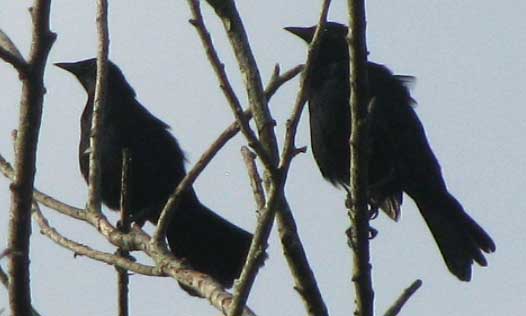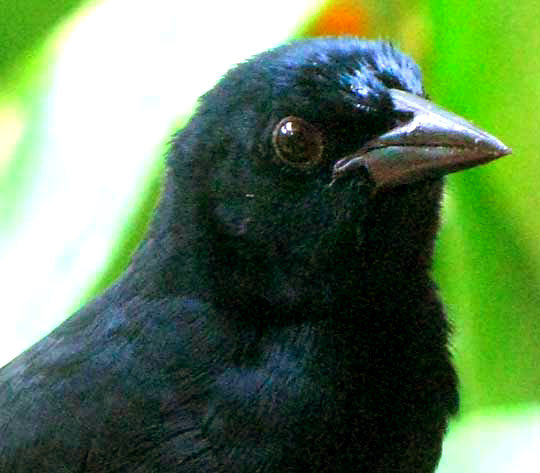Excerpts from Jim Conrad's
Naturalist Newsletter
from the December 8, 2005 Newsletter, issued from San Juan Hacienda near Telchac Pueblo, Yucatán, MÉXICO
COOPERATIVELY SINGING MELODIOUS BLACKBIRDS
Melodious Blackbirds are common from central Mexico to Costa Rica. We have lots of them at the hacienda. They are like the US's Red-winged Blackbirds except that they are totally black. That's a couple of them below:
I'm astonished that my field guides do not mention something remarkable I am seeing these birds do every morning: They are "cooperatively singing." Two birds cooperate in making a call that sounds like it is coming from a single bird.
The songs are very varied but a classic case arises when two birds are perching together high in a tree preening as the rising sun warms them up. One bird suddenly makes itself taller and stands stiffly, enlarges his chest and ruffles his feathers, and opens his beak.
His companion, seeing these signs, does the same. Then follows a two-bird-made song in which one bird makes a piercing POING call, which can sound a little like a much amplified drop of water in a bathroom sink.Another part of the call is a loud CHRRR or maybe a metalic-sounding ping, which may begin the call. The two birds alternate their calls for several seconds and it sounds exactly as if one bird were making a single very melodious call. As the birds call they pump up and down on their legs, alternating with one another.
Sometimes the cooperating birds can be 50 or more feet apart, in different trees, but then the complementary effect is not nearly as coordinated. The calls are usually out of phase and often the birds don't bother to pump their legs with such vigor. They need to be about two feet apart to really do a good job. Often, especially later in the day, birds sing alone, performing just one part of the song, and sometimes lone birds call with other sounds not incorporated in the POING CHRRR or PING POING call. Lone birds don't seem nearly as enthusiastic about their calling as birds in a pair cooperatively singing.
Apparently these callings are at least partly meant to defend territory, because when a couple nearby calls I can hear far away another couple responding.
from the July 25, 2010 Newsletter, issued from Hacienda Chichen adjoining the ruins of Chichén Itzá, Yucatán, MÉXICO
VIDEO OF COOPERATIVELY SINGING MELODIOUS BLACKBIRDS
Having no tripod, I've pretty much given up on making videos with my little handheld digital camera because the images always bounce around so much. However, this week I really wanted to show you how the blackbirds serenade me each morning during breakfast, so I videoed them, the image is as bouncy as ever, but at least you can see what's happening, see them pumping their bodies and taking turns calling.
If your browser can view You-Tube videos and handle Javascript, maybe you can see them beginning with some calling, then doing some preening and looking around, then calling again, below:
from the November 8, 2009 Newsletter, issued from Hacienda Chichen Resort beside Chichén Itzá Ruins, central Yucatán, MÉXICO; limestone bedrock, elevation ~39m (~128ft), ~N20.676°, ~W88.569°
MELODIOUS BLACKBIRD UP CLOSE
There's not much to these birds' coloration other than being black. However, this species is apt to come up to the Hacienda's dining area and perch on the wrought-iron railing, apparently hoping for a handout. A close-up of one's head is shown below:

You also see Melodious Blackbirds hopping around on the much-manicured lawn. Unlike some birds who sing in the early morning and maybe a bit before dawn, you hear Melodious Blackbirds calling all day long, and that's OK with me, for their song is delightful, a pretty thing to hear. And knowing that it's "cooperatively sung" just adds to the charm.